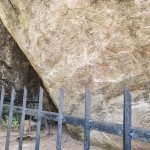I feel like months have already passed, but I’m still just finishing my first week here. Monday is Navam Poya, a public holiday, so I’ve got a brief opportunity to see some of Sri Lanka before I go back to CSTH’s surgical wards. Sri Lanka has no shortage of amazing historicalsites, and has had complex influences from India, China, the Netherlands, Portugal, Britain, and more. With only a brief window moment to explore, though, it was impossible to pass up Anuradhapura, home to some of the world’s most famous Buddhist sites.
I grew up around a lot of different religions, but I still have a loose grasp on Buddhism. It’s clearly an important part of understanding the culture here, with 70% of Sri Lankans practicing Theravada Buddhism as the state religion (with the other major groups being Hindu, Muslim, and Christian). My understanding is still very simplistic and probably error-laden, but so far I understand as follows. Theravada is the oldest extant school of Buddhism, and maintains its scriptures in the sacred Pāli language, which can be thought of filling a role like Ecclesiastical/Church Latin, Sanskrit, or Classical Arabic. Like other forms of Buddhism, it discusses the impermanence of all things (anicca), the existence of suffering (dukkha), and ways to escape it (magga). Life takes places in an endless cycle of rebirth (saṃsāra) into one of six realms ranging between that of the pseudo-gods (deva) and a hellish purgatory (Niraya), with the overall goal being to escape this rebirth cycle by achieving nirvana. All of this was preached by Siddhattha Gotama, the Buddha, who is just one of a long line of Buddhas from both the past and theprophesised future.
Kasun and I boarded the bus to Anuradhapura, and soon found ourselves in the sacred city. It was once capital of the Kingdom of the same name, the first Kingdom Sri Lanka had ever seen, and had existed for almost 1400 years from 377 BC. Anuradhapura was named after Anuradha, a minister to King Vijaya (and literally meaning City of Anuradha). Today, Anuradha’s City is a renowned UNESCO World Heritage Site. With only enough time to see a few things, we opted to visit the Gotama Buddha’s renowned sacred fig tree, the Jaya Sri Maha Bodhi (ජය ශ්රී මහා බොධිය), a 2300 year-old cutting from the tree under which he is said to have first gained his enlightenment. The cutting lies supported upon golden prongs above several tiered platforms, and only the most senior of monks can get a closer look. Looking at it and imagining it being there for over two thousand years is difficult to process. People came with offerings to pay their respects, and despite the huge crowds the place evoked a strong feeling of peace. A short distance away was the Ruwanweli Maha Seya (රුවන්වේලි මහා සේයා), an enormous stupa (a mound-like religious site where remains of monks or other treasures are interred). Construction began in 140 BC, but it was eventually lost to time and fell into disrepair, until its rediscovery and restoration through the 20th Century. Somewhere inside the stupa is said to be some of the relics of Gotama Buddha himself, so the site is of course of huge importance. At over 100metres high – an unbelievable height for its age – it’s impossible not to be floored by the structure, which shines so brilliantly in the Sun that it’s scarcely possible to look directly at it. I filled oil lamps and lit incense sticks to pay my respects, took in as much as I could, and we were once more swept back into the crowds.
Before leaving the city, we had time to visit one more historical site. Ranmasu Uyana (රන්මසු උයන) seems at first like any other park, until you begin to stumble across slabs of stone scattered around you, seemingly in meaningful patterns. Friezes of elephants lie carved upon the banks, and what can only be described as an empty, ancient swimming pool opens out amongst the grass. It all seems too surreal to be truly ancient, but these really are the remains of Royal Gardens (Magul Uyana, මගුල් උයන) that were in use between the 3rd Century BC and 9th Century AD. For hundreds of years, this was a Bahamas beach to a Buddhist King. Royalty would come here to relax here with their wives, taking advantage of Sri Lanka’s revolutionary, world-leading canal and irrigation technology that used pressure differences to pump the pools full. At the time, it must have seemed almost like magic. Today it feels as though the archaeologists are on lunch break, and you’ve snuck into the site.
There was one last treasure to seek out, which had recently become a sensation online. Around the corner, past several troops of wild monkeys, we came across a man praying at a strange circular carving. This was the mystical ‘stargate’ that had come to capture the attention of Sri Lankan netizens. Hypotheses about the meaning of the carving and its history vary wildly, ranging from being an astronomical or geographical map to a stargate that communicates with extra-terrestrials. If the monkeys knew anything, they weren’t talking.






No comments yet.
Leave a comment